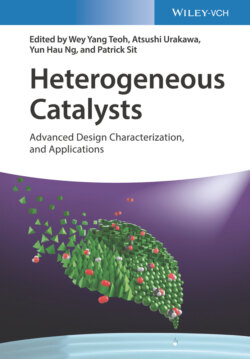Читать книгу Heterogeneous Catalysts - Группа авторов - Страница 53
4.2.5 Catalyst on Carbon Material from Hydrothermal Carbonization of Biomolecules
ОглавлениеHydrothermal carbon is synthesized by the treatment of biomass or carbohydrate molecules under high pressure hydrothermal conditions [36]. The carbonaceous material produced has a spherical shape and diameters of a few hundreds of nanometers and contains high oxygen content (30–40%). It is characterized by hydrophilic external layers, while being more hydrophobic (bearing less oxygen) at the core.
Metal catalysts have been prepared using the one‐pot approach by introducing a metal precursor during the hydrothermal treatment. Depending on the metal precursor, the metal is deposited on the external hydrophilic surface or on the internal hydrophobic surface. Hydrophobic metal precursors such as Pd acetylacetonate tend to be reduced on the internal hydrophobic core of the carbon spheres, leading to the metal core–carbon–shell structure (Figure 4.4) [37]. The catalyst shows higher selectivity in the hydrogenation of phenol to cyclohexanone compared to the charcoal‐supported catalyst. The enhanced performance of the former was attributed to hydrophilicity of the carbon shell. On the other hand, transition‐metal ions (Fe3+, Ni2+, Co2+, Ce4+, Mg2+, and Cu2+), which are less reducible, tend to bound to the hydrophilic shell of the carbon particles, leading to carbon core–metal shell structures upon calcination [38].
Figure 4.4 Hydrothermal carbon spheres (a) and noble metal@carbon core–shell structures (b).
Source: Makowski et al. 2008 [37]. Reprinted with permission of Royal Society of Chemistry.
To the best of our knowledge, there are only a handful of examples in the literature on the use of hydrothermal carbon for catalytic applications, either as metal‐free or hybrid catalysts with supported metals or metal oxides. For instance, hybrid inorganic–organic niobia–carbon catalyst has been prepared in one pot by hydrothermal carbonization of glucose, ammonium niobium oxalate, and urea [39]. Improved hydrothermal stability for aqueous‐phase reactions was demonstrated for the highly dispersed niobia particles embedded within carbon. Besides the addition of active phase in one pot, metal active phase has been supported on previously prepared hydrothermal carbons in a second step. In some cases, the hydrothermal carbon materials are further carbonized in an inert atmosphere at high temperatures. In a recent work, hydrothermal carbon spheres were graphitized at 1900 °C, on which cobalt Fischer–Tropsch catalyst was subsequently dispersed by both chemical vapor deposition (CVD) and wet impregnation [40]. In both cases, the primary particles had a mean size of 5 nm, whereas the catalyst particles prepared by wet impregnation were aggregated up to 100 nm. The former produced 5 times more oxygenates than conventional Co on alumina catalyst.
The use of hydrothermal carbon in catalysis is still in its infancy. The hydrothermal carbon material has the potential as a catalyst support due to its natural origin, sustainable production process, and the ability to tune the carbon material properties (porosity, wetting properties, amphiphilicity, doping) for different reactions.
